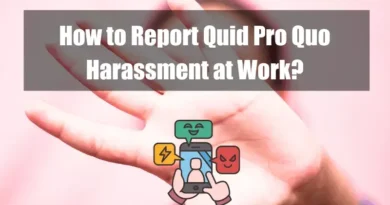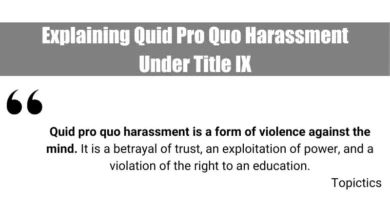Here are the key takeaways on quid pro quo harassment and retaliation:
- Quid pro quo harassment involves a supervisor demanding sexual favors in exchange for job benefits or to avoid negative consequences, which violates Title VII of the Civil Rights Act and other state laws. Retaliation occurs when employers punish employees for rejecting advances or reporting harassment, often through demotion, firing, or exclusion, and is equally illegal under federal law.
- Employer responsibility includes preventing both harassment and retaliation by implementing anti-harassment policies and protecting employees from punishment for reporting misconduct.
- Legal recourse allows victims to seek compensation for lost wages, emotional distress, and punitive damages by filing complaints with agencies like the EEOC.
Let’s discuss in detail:
Introduction
Quid pro quo harassment occurs when a person in authority, such as a supervisor, demands sexual favors in exchange for work-related benefits or to avoid negative consequences like demotion or firing. It violates federal and state laws; victims can report it to agencies like the EEOC. Retaliation, which is also illegal, happens when an employer punishes an employee for reporting harassment, often through actions like firing or demotion. Both behaviors create toxic work environments and can cause significant emotional and professional harm.
To establish a quid pro quo harassment case, several elements must be present. These include proof that the harasser was in a supervisory or decision-making position, that the victim was subject to unwanted sexual advances, and that the harassment impacted their employment status or opportunities. Importantly, victims do not need to show that the harassment was pervasive or severe, as is often required in hostile work environment claims. Even a single instance of quid pro quo harassment can be enough to form a legal claim if it has tangible employment consequences.

Retaliation Following Quid Pro Quo Harassment
Retaliation often follows instances of quid pro quo harassment, particularly when victims report misconduct or refuse sexual advances. Retaliation can take many forms, including unjustified termination, demotion, negative performance reviews, exclusion from important meetings, or reassignment to less desirable tasks. The law is clear that retaliation is also illegal. Employees have the right to report harassment without fear of adverse consequences, and employers who retaliate against workers for reporting harassment can face additional legal penalties.
Victims of retaliation, much like victims of harassment, are entitled to seek damages. This can include compensation for lost wages, emotional distress, and legal fees. In some cases, courts may also award punitive damages if the retaliation was particularly egregious or if the employer failed to prevent or address the harassment properly. Under Title VII and many state laws, it is illegal for employers to take punitive actions against employees for opposing unlawful practices like harassment or for participating in investigations or legal proceedings related to harassment.
Scenarios
In real-world cases, quid pro quo harassment and retaliation often occur together, with retaliation following after an employee rejects advances or reports harassment. For example, a manager may offer a promotion or a raise in exchange for a sexual favor. If the employee refuses, the manager may retaliate by giving the employee poor performance reviews, demoting them, or even firing them.
Another example is a female employee who reports that her supervisor requested a sexual relationship in exchange for a promotion. After she refused and reported the incident to human resources, she was excluded from important meetings and eventually fired. This example highlights both the initial quid pro quo harassment and the subsequent retaliation that can occur when victims take a stand.
Retaliation can happen when an employee is punished after filing a complaint or participating in an investigation. In such cases, victims often face a hostile work environment, making it difficult to continue working, further underscoring the need for robust legal protections and employer accountability.
Legal Protections and Employer Responsibility
Both quid pro quo harassment and retaliation are prohibited by federal and state laws, with employers carrying significant responsibilities to prevent and address such misconduct. Under Title VII of the Civil Rights Act of 1964, it is illegal for employers to tolerate quid pro quo harassment, which occurs when a supervisor or person in power demands sexual favors in exchange for job benefits or threatens negative consequences for refusal. The Equal Employment Opportunity Commission (EEOC) enforces these protections and holds employers accountable for failing to address harassment or retaliation.
Employers are also responsible for preventing retaliation, which often follows the reporting of quid pro quo harassment. Retaliation, like harassment, is illegal under Title VII, and employers are obligated to protect employees who exercise their rights by reporting harassment or discrimination. Many states, such as California and New York, have additional protections that provide further legal avenues for victims of harassment and retaliation.
Employers are required to implement clear anti-harassment policies, provide training, and establish reporting procedures. Failure to take these steps or to address harassment or retaliation can result in liability for the company. Victims can file complaints with the EEOC or state agencies, which may lead to investigations and legal action against the employer.
Seeking Justice and Compensation
Victims of quid pro quo harassment and retaliation have several legal avenues for seeking justice and compensation. Employees who experience harassment can file a complaint with the EEOC or their state’s equivalent agency. Once a complaint is filed, the agency will investigate the allegations and may facilitate a settlement between the employee and employer. If no settlement is reached, the employee may be able to file a lawsuit. Compensation for victims can include back pay, lost benefits, emotional distress damages, and, in some cases, punitive damages.
Punitive damages may be awarded in particularly egregious cases where the employer was found to be willfully negligent in addressing harassment or retaliation. These damages are intended to punish the employer and deter similar conduct in the future. Emotional distress compensation can also be significant, particularly if the harassment or retaliation led to long-term psychological harm, such as anxiety or depression. Additionally, if the victim lost their job or was demoted due to retaliation, they may be entitled to compensation for lost wages and benefits.
In order to pursue a legal claim, victims must document every instance of harassment or retaliation. Keeping detailed records of communications, incidents, and any interactions with HR or management can strengthen a case. Many victims find it helpful to consult with an employment attorney specializing in harassment and retaliation cases, as these professionals can guide them through the legal process and help them secure appropriate compensation.
Conclusion
- Quid pro quo harassment and retaliation are serious legal violations that can have devastating consequences for victims. Under both federal and state laws, employees are protected from such misconduct, and employers are held accountable for ensuring a safe and respectful workplace.
- While many victims fear reporting the abuse due to the possibility of retaliation, the law is clear that retaliation is also illegal and can result in additional damages for the victim.
- By understanding their rights and seeking legal assistance, victims can take action to hold their harassers accountable and secure justice for the harm they have endured.









